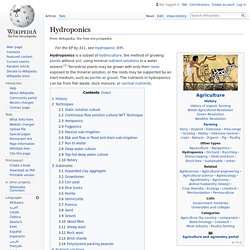

Vegetable Spacing Guide". 5 Secrets to a ‘No-work’ Garden. It took over 20 years of gardening to realize that I didn’t have to work so hard to achieve a fruitful harvest.

As the limitless energy of my youth gradually gave way to the physical realities of mid-life, the slow accretion of experience eventually led to an awareness that less work can result in greater crop yields. Inspired in part by Masanobu Fukuoka’s book, One Straw Revolution, my family experimented with gardening methods which could increase yields with less effort. Hydroponics. NASA researcher checking hydroponic onions with Bibb lettuce to his left and radishes to the right Hydroponics is a subset of hydroculture, the method of growing plants without soil, using mineral nutrient solutions in a water solvent.[1] Terrestrial plants may be grown with only their roots exposed to the mineral solution, or the roots may be supported by an inert medium, such as perlite or gravel.

The nutrients in hydroponics can be from fish waste, duck manure, or normal nutrients. History[edit] In 1929, William Frederick Gericke of the University of California at Berkeley began publicly promoting that solution culture be used for agricultural crop production.[3][4] He first termed it aquaculture but later found that aquaculture was already applied to culture of aquatic organisms.
Farming the Cities, Feeding an Urban Future. WASHINGTON - June 16 - As people move from rural to urban settings in search of economic opportunities, urban agriculture is becoming an important provider of both food and employment, according to researchers with the Worldwatch Institute.

"Urban agriculture is providing food, jobs, and hope in Nairobi, Kampala, Dakar, and other cities across sub-Saharan Africa," said Danielle Nierenberg, co-director of the Institute's Nourishing the Planet project. "In some cases, urban farmers are providing important inputs, such as seed, to rural farmers, dispelling the myth that urban agriculture helps feed the poor and hungry only in cities. " The United Nations projects that up to 65 percent of the world's population will live in cities by 2050, up from around 50 percent today. The rate of urban migration is particularly high in sub-Saharan Africa and South Asia, where inadequate urban infrastructure struggles to keep up with the large influx of people.
Close to home (and market).